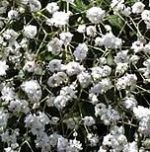 Baby’s breath is a herbaceous perennial and a member of the carnation family, Caryophyllaceae, that also includes pinks and campions. It is native to central and eastern Europe but is naturalized in North America and is now considered invasive from new Brunswick to British Columbia, south to Pennsylvania, Oklahoma, and California. Plants grow 2-4′ tall and have highly branched stems with narrow, gray-green leaves up to 4″ long and panicles 1/16″ wide white flowers in mid-summer. Anybody who has ever seen a bouquet of flowers from a florist has probably seen baby’s breath because it is the number one filler flower for florists. It’s virtues, however, don’t stop there and it can be a very useful and attractive garden flower especially when planted in groups of 3 to 4. The plant emerges from the soils as the spring flowers are blooming and then bursts into bloom as a huge frothy mound that covers the dying foliage of bulbs as well as plants like oriental poppies that go dormant in the summer. The flowering stems provide a fine airy texture and act like a filler in the garden just as it does in flower arrangements. Gypsophila is a long day plant and flowers more quickly when the daylength is more than 14 hours. The genus name Gypsophilia comes from the Greek words gypsos meaning chalk and philia meaning friendship which refers to the plants’ fondness for soils with a high pH. The addition of lime to acidic soil is probably necessary for all the members of the genus to thrive. The specific epithet, paniculata, comes from the Greek word penos meanning web and refers to the arrangement of the flowers.
Baby’s breath is a herbaceous perennial and a member of the carnation family, Caryophyllaceae, that also includes pinks and campions. It is native to central and eastern Europe but is naturalized in North America and is now considered invasive from new Brunswick to British Columbia, south to Pennsylvania, Oklahoma, and California. Plants grow 2-4′ tall and have highly branched stems with narrow, gray-green leaves up to 4″ long and panicles 1/16″ wide white flowers in mid-summer. Anybody who has ever seen a bouquet of flowers from a florist has probably seen baby’s breath because it is the number one filler flower for florists. It’s virtues, however, don’t stop there and it can be a very useful and attractive garden flower especially when planted in groups of 3 to 4. The plant emerges from the soils as the spring flowers are blooming and then bursts into bloom as a huge frothy mound that covers the dying foliage of bulbs as well as plants like oriental poppies that go dormant in the summer. The flowering stems provide a fine airy texture and act like a filler in the garden just as it does in flower arrangements. Gypsophila is a long day plant and flowers more quickly when the daylength is more than 14 hours. The genus name Gypsophilia comes from the Greek words gypsos meaning chalk and philia meaning friendship which refers to the plants’ fondness for soils with a high pH. The addition of lime to acidic soil is probably necessary for all the members of the genus to thrive. The specific epithet, paniculata, comes from the Greek word penos meanning web and refers to the arrangement of the flowers.
Type: Herbaceous perennial
Bloom: Tiny white flowers are borne in large panicles in mid-summer
Foliage: Narrow, 4” gray-green leaves grow in rosettes.
Size: 2-4’ H x 3’ W
Light: Full sun
Soil: Average, medium dry, well-drained, basic (7.0-7.5)
Hardiness: Zones 3-9
Care: Cut back after first bloom to encourage rebloom in fall.
Pests and Diseases: None of significance; susceptible to botrytis and aster yellows
Propagation: Seed, division, terminal cuttings after flowering.
Companion plants: Liatris, Veronic spp., purple coneflowers, roses, lavender; plant with bulbs and spring blooming plants that go dormant in summer like bleeding heart and oriental poppy to cover yellowing foliage and fill empty spots.
Outstanding Selections:
‘Bristol Fairy’
-
- (double white flowers, 2’ tall)
‘Pink Fairy’
- (like ‘Bristol Fairy’ but with pink flowers)
